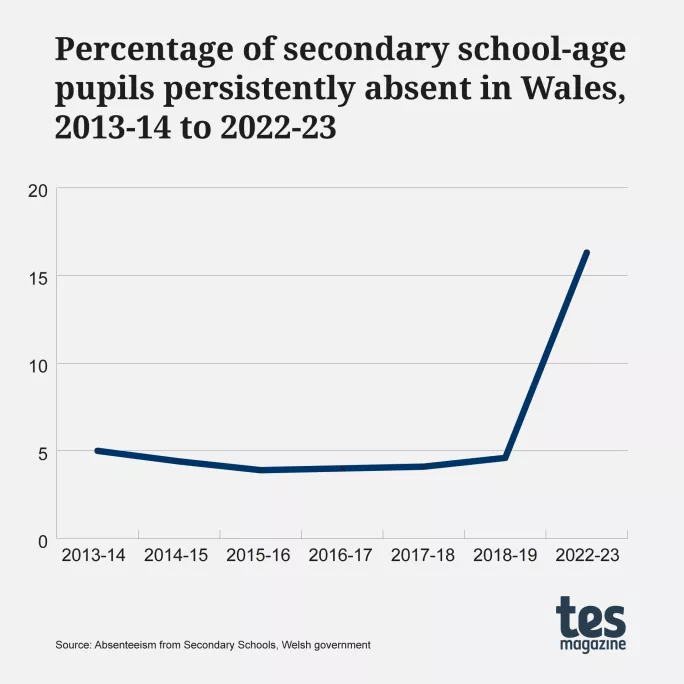Wales to set up school attendance taskforce

School attendance is “a global concern” and one that must be taken “seriously” - that was the conclusion of the Welsh education minister Jeremy Miles, who was responding to new data that laid bare the extent of the problem in the nation’s secondary schools.
In response, he has announced “a national attendance taskforce” to “drive improvements” in attendance and re-engage pupils in Wales.
Meanwhile, headteachers have said the key to improving attendance is greater investment in support for families so that the “complex, deep-rooted issues” which act as a barrier to pupils coming to school can be addressed.
Figures on secondary school absence rates - published for the first time yesterday since 2018-19 - show the percentage of secondary students persistently absent from school last year trebled to 16.3 per cent.
Between 2013-14 and 2018-19 the percentage of pupils that were persistently absent from secondary remained stable at between 4 per cent and 6 per cent of pupils.
This means that while before the pandemic, about one in 20 secondary pupils was persistently absent, last year that increased to one in six.
Persistent absence is defined as a pupil being absent at least 20 per cent of the time. So, if most are required to be in school for 300 half-day sessions in the year, the threshold for persistent absence is 60 sessions.

The figures show that secondary students entitled to free school meals are more likely to be persistently absent from school, as are those in older year groups.
Key figures include:
- The percentage of half-day sessions missed by secondary students almost doubled to 12.5 per cent between 2018-19 and 2022-23.
- Secondary students eligible for free school meals (FSM) missed 20.7 per cent half-day sessions in 2022-23, while secondary students not eligible for FSM missed 10 per cent of half-day sessions. Both figures are approximately double the rate of absences in 2018-19.
- 15.6 per cent of half-day sessions were missed by Year 11 students, compared with 9.4 per cent of half-day sessions missed by Year 7 pupils, in 2022-23.
- 35.7 per cent of secondary students eligible for FSM were persistently absent in 2022-23, compared with 11.2 per cent ineligible for FSM.
- 22.5 per cent of Year 11 students were persistently absent, compared with 10.2 per cent of Year 7 pupils, in 2022-23.
Mr Miles said in a written statement that the figures were “a stark reminder” of the continuing impact of Covid on pupils.
He said much had already been done to improve attendance, including increasing the investment in family engagement officers this year to more than £6.5 million, and that new engagement and attendance guidance would be “published in the coming weeks”.
On the national attendance taskforce, Mr Miles said understanding what was making children less willing to attend school was critical and that a multi-agency approach was required.
Leaders in education, health, social service, the police, the private sector and the community would be involved in the taskforce and the group would “draw on the input of parents and learners themselves”.
Mr Miles said he would announce the membership of the taskforce to coincide with the publication of the new attendance guidance.
He added: “There are often complex and multiple factors lying behind non-attendance.”
These could include mental health and wellbeing, availability of specific learning support services, and the ever-rising cost of living and attitudes of parents and learners towards school attendance generally, he said.
“As such, a priority of the group will be to look in depth into the reasons behind non-attendance and bring to bear their expertise to identify actions that can bring about sustained improvements.”
Laura Doel, national secretary of school leaders’ union, NAHT Cymru, said that families were grappling with the cost-of-living crisis as well as growing challenges with mental ill health and anxiety among pupils. In some cases, she said, there had been a shift in parental attitudes towards attendance.
She said: “We need to see a coordinated, government-led strategy to ensure children and families get the help they need with challenges in their lives, supported by significant new investment.
Small Welsh government schemes to provide family engagement officers have helped some schools, she said, “but this kind of support needs to be business as usual everywhere if it is to lead to sustained improvement across Wales”.
She added: “Other schemes to improve pupil attendance, like mentoring, expanding the provision for schools to support pupils with additional learning needs, and broader early help for families from local authorities and the health service all need to be considered if we are to combat this problem.”
You need a Tes subscription to read this article
Subscribe now to read this article and get other subscriber-only content:
- Unlimited access to all Tes magazine content
- Exclusive subscriber-only stories
- Award-winning email newsletters
Already a subscriber? Log in
You need a subscription to read this article
Subscribe now to read this article and get other subscriber-only content, including:
- Unlimited access to all Tes magazine content
- Exclusive subscriber-only stories
- Award-winning email newsletters



